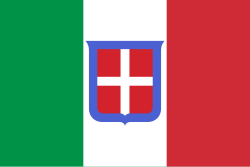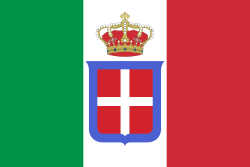Kingdom of Italy (1861–1946)
The Kingdom of Italy was a country that started in 1861 after the Italian unification and ended with the dissolution of the monarchy in 1946. In 1922, it became Fascist Italy. After defeat in World War II, the people voted in 1946 to change it into the modern day Italian Republic.
Kingdom of Italy Regno d'Italia | |
|---|---|
| 1861–1946 | |
| Motto: | |
| Anthem: | |
 The Kingdom of Italy in 1942 | |
| Capital | Rome |
| Demonym(s) | Italian |
| Government | Constitutional monarchy and Fascist dictatorship |
| Legislature | Italian Parliament |
| History | |
• | 1861 |
• | 1946 |
| Area | |
• Total | 310,190 km2 (119,770 sq mi) |
| Population | |
• Estimate | 42,993,602 (1936) |
| Currency | Italian lira |
| Today part of | Italian Republic (mainly), Slovenia, Croatia |
History
Unification
Before 1861, Italy was not one country. Instead, there were many kingdoms and duchies (places ruled by dukes) in the Italian Peninsula. In 1861, the King Victor Emmanuel II, who was the king of the Kingdom of Sardinia wanted to unite Italy, and he invaded the countries. Later, they all became one country and King Victor Emmanuel II became the King of Italy.
Colonies
Italy began their colonial empire in the 1880s, when they conquered Eritrea and Somalia. In 1912, they took Libya from the Ottoman Empire. In 1936, Italy also conquered Ethiopia, creating Italian East Africa. When they lost WW2, their colonies were lost to the British Empire and the French Empire.
Fascism
Kingdom Of Italy (1861–1946) Media
The Royal March, italian national anthem from 1861 to 1943/1946.
Notice of the proclamation of the Statuto Albertino in 1848 by King Charles Albert of Sardinia
The Iron Crown of Lombardy, for centuries a symbol of the kings of Italy
Before World War I, Italy was friends with the German Empire and Austria-Hungary. But Italy wanted parts of Austria-Hungary. In 1915, the United Kingdom promised the lands of South Tyrol, Istria and Dalmatia, and Italy joined the Triple Entente. After Italy won WW1, Italy did not get all of those places. After the Blackshirts' March on Rome of 1922, Benito Mussolini became Prime Minister. He was the leader of the National Fascist Party and did not like Italy not getting all their promised land in WWI. He made Italy into a dictatorship without much liberty.
When World War II began, Mussolini led Italy into alliance with Hitler and the Axis powers. In 1943 the Allies of World War II invaded and began conquering Italy. Mussolini's leadership ended and he was killed in 1945. Nazi Germany controlled Italy at that time, but Germany also eventually was invaded by the Allies. Hitler killed himself and Nazi Germany surrendered. Italy was independent again.
Aftermath of World War II
After WWII, Italy was left in huge debt, causing Italy to be poor. Many people from Italy emigrated to the United States to escape being poor. In 1946, the people voted to get rid of the monarchy (kings and queens) and establish the new Italian Republic. Slowly, the new government helped Italy get back up again into its current state. Also, dramatically, people stopped emigrating because life in Italy was becoming better.
List of monarchs
- Victor Emmanuel II (1861–1878)
- Umberto I (1878–1900)
- Victor Emmanuel III (1900–1946)
- Umberto II (1946)









